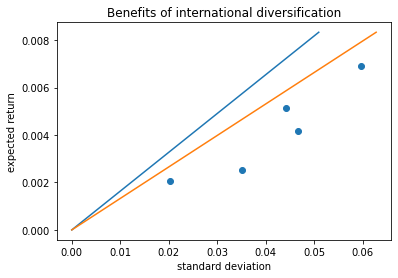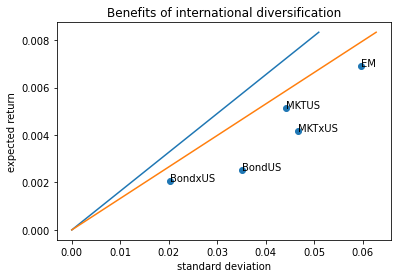Case study on international portfolio diversification
Contents
import pandas as pd
import numpy as np
import matplotlib.pyplot as plt
%matplotlib inline
#GlobalFinMonthly
url="https://raw.githubusercontent.com/amoreira2/Lectures/main/assets/data/GlobalFinMonthly.csv"
Data = pd.read_csv(url,na_values=-99)
Data['Date']=pd.to_datetime(Data['Date'])
Data=Data.set_index(['Date'])
9.2. Case study on international portfolio diversification#
In this section we will apply what we have learned so far on the international market. We will try to solve the optimal weights that give us the highest sharpe ratio, and how we should allocate our money between risk-free rate and risky asset to target on average return or volatility.
Data.head()
| RF | MKT | USA30yearGovBond | EmergingMarkets | WorldxUSA | WorldxUSAGovBond | |
|---|---|---|---|---|---|---|
| Date | ||||||
| 1963-02-28 | 0.0023 | -0.0215 | -0.001878 | 0.098222 | -0.002773 | NaN |
| 1963-03-31 | 0.0023 | 0.0331 | 0.003342 | 0.014149 | 0.000371 | 0.001913 |
| 1963-04-30 | 0.0025 | 0.0476 | -0.001843 | -0.147055 | -0.003336 | 0.008002 |
| 1963-05-31 | 0.0024 | 0.0200 | -0.001807 | -0.012172 | -0.000186 | 0.004689 |
| 1963-06-30 | 0.0023 | -0.0177 | 0.001666 | -0.055699 | -0.011160 | 0.003139 |
# for convenience lets rename these assets
Data=Data.rename(columns={Data.columns[1]: "MKTUS",Data.columns[2]: "BondUS",
Data.columns[3]: "EM",Data.columns[4]: "MKTxUS",Data.columns[5]: "BondxUS" })
Data.tail()
| RF | MKTUS | BondUS | EM | MKTxUS | BondxUS | |
|---|---|---|---|---|---|---|
| Date | ||||||
| 2016-08-31 | 0.0002 | 0.0052 | -0.008417 | 0.025186 | 0.000838 | -0.009552 |
| 2016-09-30 | 0.0002 | 0.0027 | -0.016417 | 0.013153 | 0.012736 | 0.009979 |
| 2016-10-31 | 0.0002 | -0.0200 | -0.049460 | 0.002474 | -0.020383 | -0.043476 |
| 2016-11-30 | 0.0001 | 0.0487 | -0.081636 | -0.045971 | -0.019798 | -0.050359 |
| 2016-12-31 | 0.0003 | 0.0185 | -0.005296 | 0.002904 | 0.034383 | -0.023207 |
Lets start by constructing a matrix with only excess returns
#
Re=(Data.drop('RF',axis=1)).subtract(Data['RF'],axis='index')
Re.tail()
| MKTUS | BondUS | EM | MKTxUS | BondxUS | |
|---|---|---|---|---|---|
| Date | |||||
| 2016-08-31 | 0.0050 | -0.008617 | 0.024986 | 0.000638 | -0.009752 |
| 2016-09-30 | 0.0025 | -0.016617 | 0.012953 | 0.012536 | 0.009779 |
| 2016-10-31 | -0.0202 | -0.049660 | 0.002274 | -0.020583 | -0.043676 |
| 2016-11-30 | 0.0486 | -0.081736 | -0.046071 | -0.019898 | -0.050459 |
| 2016-12-31 | 0.0182 | -0.005596 | 0.002604 | 0.034083 | -0.023507 |
Now we estimate the expected return and the covariance using the sample moments
ERe=Re.mean()
ERe
MKTUS 0.005140
BondUS 0.002523
EM 0.006923
MKTxUS 0.004149
BondxUS 0.002054
dtype: float64
Now we estimate the covariance matrix
CovRe=Re.cov()
CovRe
| MKTUS | BondUS | EM | MKTxUS | BondxUS | |
|---|---|---|---|---|---|
| MKTUS | 0.001948 | 0.000111 | 0.001292 | 0.001264 | 0.000187 |
| BondUS | 0.000111 | 0.001227 | -0.000204 | -0.000013 | 0.000264 |
| EM | 0.001292 | -0.000204 | 0.003556 | 0.001661 | 0.000249 |
| MKTxUS | 0.001264 | -0.000013 | 0.001661 | 0.002182 | 0.000422 |
| BondxUS | 0.000187 | 0.000264 | 0.000249 | 0.000422 | 0.000407 |
First we will solve for the maxium Sharpe ratio feasible:
\(\begin{align} SR(R^*)&=\sqrt{E[R^e]'Var(R^e)^{-1}E[R^e]} \end{align}\)
Then we will solve for the weights that implement this Sharpe ratio
And then we will solve for the position on it that implements a desired level of volatility or expected returns
SR_int=(ERe @ np.linalg.inv(CovRe) @ ERe)**0.5
SR_int
0.163687548954056
# annualized
SR_int*12**0.5
0.5670303027096856
# compares with market
Re.MKTUS.mean()/Re.MKTUS.std()*12**0.5
0.4034509726765917
We will now initate an empty dataframe that has in the columns the names of the assets
We will use it to store the different portfolios that you solve for
Wmve=pd.DataFrame([],index=Re.columns)
Wmve
| MKTUS |
|---|
| BondUS |
| EM |
| MKTxUS |
| BondxUS |
Wmve['International'] =np.linalg.inv(CovRe) @ ERe
Wmve
| International | |
|---|---|
| MKTUS | 1.835334 |
| BondUS | 1.423373 |
| EM | 1.605223 |
| MKTxUS | -1.026421 |
| BondxUS | 3.365823 |
9.2.1. Targeting desired Voaltiltiy#
We will first find the particular scaling of the tangendy porfolio that implements a desired level of volatility
We shown that for weights \(X=E[R^e]'Var(R^e)^{-1}\), the volatility is \(\sigma(X'R^e)=\sqrt{E[R^e]'Var(R^e)^{-1}E[R^e]}\)
Thus to get a portfolio of vol \(\sigma^D\) all we need to lever it up/down by this factor
This dominator alos happens to be Sharpe-Ratio of the tangency portfolio
So you simply scale down the weights depending on whether your desired volatiltiy.
In this case the obtained expected excess return is
# I am setting the target to be annual volatiltiy of 20% and
# I am converting back to monthly by dividing by square roo of 12
sigma_desired=0.20/12**0.5
print(sigma_desired/SR_int)
Wmve['International(voltarget)']=(sigma_desired/SR_int)*(np.linalg.inv(CovRe) @ ERe)
Wmve
0.35271483559918
| International | International(voltarget) | |
|---|---|---|
| MKTUS | 1.835334 | 0.647349 |
| BondUS | 1.423373 | 0.502045 |
| EM | 1.605223 | 0.566186 |
| MKTxUS | -1.026421 | -0.362034 |
| BondxUS | 3.365823 | 1.187176 |
9.2.2. Targeting Desired Expected Return#
\(\begin{align} \mu^{D}&=r_f+wE[R^*] \\ w &=\frac{\mu^{D}-r_f}{E[R^*]} \\ &=\frac{\mu^{D}-r_f}{E[R^e]'VAR(R^e)^{-1}E[R^e]} \\ &=\frac{\mu^{D}-r_f}{SR_*^2} \\ \end{align}\)
where the last step simply uses that the denominator is the square of the Sharpe Ratio of the tangency portfolio
Because SR is expected excess return over the volatility \(\mu^D-r_f=\sigma^D SR_*\), then the obtained vol is simply
If one wanted to set the target for the expected returns one ould simply subtract the current risk-free rate of this desired level
# I am setting an annual target to 10% and convert to monthly by dividing by 12
mu_desired=0.10/12
#If setting target to expected return simply use mu_desired-rf instead of mu_desired in the formulas
print(mu_desired/SR_int**2)
Wmve['International(mutarget)']=(mu_desired/SR_int**2)*(np.linalg.inv(CovRe) @ ERe)
Wmve
0.31101938812939134
| International | International(voltarget) | International(mutarget) | Domestic | Domestic(voltarget) | Domestic(mutarget) | |
|---|---|---|---|---|---|---|
| MKTUS | 1.835334 | 0.647349 | 0.570824 | 2.534954 | 1.101918 | 0.159048 |
| BondUS | 1.423373 | 0.502045 | 0.442696 | 1.827591 | 0.794434 | 0.114667 |
| EM | 1.605223 | 0.566186 | 0.499255 | NaN | NaN | NaN |
| MKTxUS | -1.026421 | -0.362034 | -0.319237 | NaN | NaN | NaN |
| BondxUS | 3.365823 | 1.187176 | 1.046836 | NaN | NaN | NaN |
9.2.3. Domestic Tangency Portfolio#
we only keep the first two columns MKT and Bonds
#ERe_dom=?
#CovRe_dom=?
The Sharpe Ratio of the domestic Tangency portolio
#SR_dom=?
#print(SR_dom*12**0.5)
0.4600987547084185
The weights of the domestic tangency portfolio
Wmvedom= np.linalg.inv(CovRe_dom) @ ERe_dom.values
Wmve.loc[['MKTUS','BondUS'],'Domestic']=Wmvedom
sigma_desired=0.20/12**0.5
print(sigma_desired/SR_dom)
Wmve.loc[['MKTUS','BondUS'],'Domestic(voltarget)']=(sigma_desired/SR_dom)*(np.linalg.inv(CovRe_dom) @ ERe_dom)
mu_desired=0.10/12
print(mu_desired/SR_dom**2)
Wmve.loc[['MKTUS','BondUS'],'Domestic(mutarget)']=(mu_desired/SR_dom**2)*(np.linalg.inv(CovRe_dom) @ ERe_dom)
Wmve
0.43468928779593713
0.47238694231134754
| International | International(voltarget) | International(mutarget) | Domestic | Domestic(voltarget) | Domestic(mutarget) | |
|---|---|---|---|---|---|---|
| MKTUS | 1.835334 | 0.647349 | 0.570824 | 2.534954 | 1.101918 | 1.197479 |
| BondUS | 1.423373 | 0.502045 | 0.442696 | 1.827591 | 0.794434 | 0.863330 |
| EM | 1.605223 | 0.566186 | 0.499255 | NaN | NaN | NaN |
| MKTxUS | -1.026421 | -0.362034 | -0.319237 | NaN | NaN | NaN |
| BondxUS | 3.365823 | 1.187176 | 1.046836 | NaN | NaN | NaN |
The difference in Sharpe ratios reveal the benefits of internaitonal diversificaiton
# this difference is the benefits of international diversification
#(SR_int-SR_dom)*12**0.5
0.10693154800126711
what does that mean?
it means for example that if you want to target a portfolio with a volatility of 5% per month (about the vol of the US market portfolio), then you get
# international diversification
voltarget=0.2/12**0.5
#[SR_int*voltarget,SR_dom*voltarget]
[0.009450505045161428, 0.007668312578473642]
How much your returns increase when you go global for this voltarget above?
# in percent?
9.2.4. Two mean-variance frontiers: For domestic and Global investors#
We will now plot the two frontiers together with the underlying assets
# # Lets visualize this in a plot including the two investment frontiers
# # set different expected return targets
# mu_target=np.linspace(0,0.1/12,20)
# # international portfolios
# plt.plot(mu_target/SR_int,mu_target)
# #Domestic portfolios
# plt.plot(mu_target/SR_dom,mu_target)
# #Individual assets
# plt.xlabel('standard deviation')
# plt.ylabel('expected return')
# plt.title('Benefits of international diversification')
# plt.scatter(Re.std(),Re.mean())
<matplotlib.collections.PathCollection at 0x216674229a0>

Lets add label to the dots so we know which asset corresponds to each point
For that I will run the same code above and add a for loop that lopps though the column name of the Re dataframe and uses the text functio to write the column name in the correct position where the x-dimension is the asset volatility and y-dimension is the asset avereage return
# mu_target=np.linspace(0,0.1/12,20)
# plt.plot(mu_target/SR_int,mu_target)
# plt.plot(mu_target/SR_dom,mu_target)
# plt.scatter(Re.std(),Re.mean())
# plt.xlabel('standard deviation')
# plt.ylabel('expected return')
# plt.title('Benefits of international diversification')
# # lets add some labels so we know which point is each portfolio
# for label in Re.columns :
# plt.text(Re.std()[label],Re.mean()[label],label)



